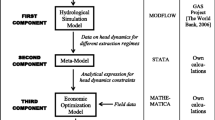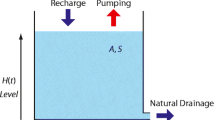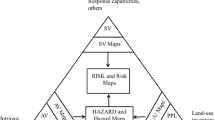Abstract
This paper explores how analytical hydrologic models can inform the effective design and choice of policy instruments to manage groundwater quality by coupling a social-planner’s problem of optimal groundwater-quality management with analytical solutions from the hydrology literature. A theoretical analysis is performed in order to characterize the properties of an optimal emissions policy. The model is then applied in a numerical analysis of groundwater contamination by chloride from highway deicers, demonstrating the relevance of the theoretical results to practical management settings. This analytical approach can help determine which policy instruments are likely to be effective in controlling groundwater pollution, especially if costly numerical groundwater models are not available for the aquifer in question. Unlike previous economic studies of groundwater contamination, this approach defines optimal emissions policies as a function of geophysical parameters employed by hydrologists such as distance between source and sink, groundwater velocity, and aquifer dispersivity. The theoretical section of this paper also demonstrates that the relationship between geophysical parameters and optimal emissions levels may be ambiguous.
Résumé
Cet article examine comment des modèles hydrologiques analytiques peuvent influencer la conception et le choix efficace d’instruments de gestion destinés à gérer la qualité des eaux souterraines en couplant un problème d’optimisation économique de la qualité des eaux souterraines avec des solutions analytiques tirées de la littérature hydrologique. Une analyse théorique est réalisée afin de caractériser les propriétés d’une politique d’épandages optimaux. Le modèle est ensuite appliqué à une analyse numérique de la contamination des eaux souterraines par le chlorure issu des sels de déneigement autoroutier, démontrant la pertinence des résultats théoriques pour une mise en œuvre pratique. Cette approche analytique peut aider à déterminer quels d’instruments de gestion sont vraisemblablement efficaces pour contrôler la pollution des eaux souterraines, particulièrement si des modèles numériques hydrogéologiques coûteux ne sont pas disponibles pour l’aquifère en question. A la différence des études économiques antérieures de contamination des eaux souterraines, cette approche définit des politiques d’épandage optimales en fonction des paramètres géophysiques utilisés par les hydrogéologues tels la distance entre la source et la perte, la vitesse d’écoulement souterrain et la dispersivité de l’aquifère. La partie théorique de cet article démontre aussi que la relation entre les paramètres géophysiques et les niveaux optima d’épandage peut être équivoque.
Resumen
Este trabajo explora como los modelos hidrológicos analíticos pueden informar acerca del diseño efectivo y la elección de instrumentos políticos para manejar la calidad del agua subterránea acoplando el problema social de un planificador de un manejo óptimo de la calidad del agua subterránea con soluciones analíticas de la literatura hidrológica. Se llevó a cabo un análisis teórico para caracterizar las propiedades de una óptima política emisiones. El modelo es luego aplicado a un análisis numérico de contaminación de agua subterránea por cloruro de descongelantes de carreteras, demostrando la relevancia de los resultados teóricos para las cuestiones prácticas del manejo. Este enfoque analítico puede ayudar a determinar que instrumentos políticos son más probablemente efectivos para controlar la contaminación del agua subterránea, especialmente para el acuífero en cuestión por si no se disponen los costosos modelos numéricos de agua subterránea. A diferencia de estudios económicos previos de contaminación de agua subterránea, este enfoque define las políticas óptimas de emisiones en función de parámetros geofísicos empleados por hidrólogos, tales como la distancia entre una fuente y un sumidero, velocidad del agua subterránea y dispersividad del acuífero. La sección teórica de este trabajo también demuestra que la relación entre parámetros y niveles óptimos de emisiones pueden ser ambiguos.
摘要
这篇文章探讨了解析水文模型是如何通过将社会规划者的优化地下水质量管理的难题与水文学文献中的解析解相结合,用有效的设计和政策手段的选择来管理地下水水质的。为刻画一个优化的排放政策的属性的特征,需进行理论性的分析。随后,此模型就可运用于由高速公路除冰装置造成的地下水氯污染的数值分析,这证实了从理论结果到实践中管理装置的相关性。这种分析方法可以帮助确定哪一种政策手段在控制地下水污染方面可能更有效,特别是当成本高昂的地下水数值模型对问题含水层不适用的时候。与之前地下水污染的经济学研究不同,这种方法将优化的排放政策定义为水文学家所使用的地球物理参数的函数之一,例如源汇项之间的距离、地下水的流速和含水层的分散性等。这篇文章的理论部分也证明了地球物理参数和优化的排放水平之间的关系可能是不明确的。
Resumo
Este artigo explora a forma como os modelos hidrológicos analíticos podem informar sobre o plano eficaz e a escolha de instrumentos de política para gerir a qualidade das águas subterrâneas, associando um problema de planeamento social da gestão ótima da qualidade das águas subterrâneas, com soluções analíticas da literatura em hidrologia. É realizada uma análise teórica, a fim de caraterizar as propriedades de uma política de emissões otimizada. O modelo é então aplicado numa análise numérica de contaminação das águas subterrâneas por cloreto usado em produtos descongeladores de autoestradas, demonstrando a relevância dos resultados teóricos para configurações de gestão práticas. Esta abordagem analítica pode ajudar a determinar quais os instrumentos de política suscetíveis de serem eficazes no controlo da poluição das águas subterrâneas, especialmente se não estão disponíveis modelos numéricos de águas subterrâneas dispendiosos para o aquífero em questão. Ao contrário de estudos económicos anteriores sobre contaminação das águas subterrâneas, esta abordagem define políticas ótimas de emissões em função de parâmetros geofísicos empregados por hidrólogos, tais como a distância entre a fonte e o sumidouro, a velocidade das águas subterrâneas, e a dispersividade do aquífero. A parte teórica deste trabalho demonstra também que a relação entre os parâmetros geofísicos e os níveis ótimos de emissões pode ser ambígua.







Similar content being viewed by others
References
Conrad J, Clark C (1987) Natural resource economics: notes and problems. Cambridge University Press, Cambridge
Craun G, Brunkard J, Yoder J, Roberts V, Carpenter J, Wade T, Calderon R, Roberts J, Beach M, Roy S (2010) Causes of outbreaks associated with drinking water in the United States from 1971 to 2006. Clin Microbiol Rev 23(3):507–528
Dillon P (1989) An analytical model of contaminant transport from diffuse sources in saturated porous media. Water Resour Res 25(6):1208–1218
Domenico P (1987) An analytical model for multidimensional transport of a decaying contaminant species. J Hydrol 91(1):49–58
Domenico P, Robbins G (1985) A new method of contaminant plume analysis. Ground Water 23(4):476–485
Domenico P, Schwartz F (1990) Physical and chemical hydrogeology. Wiley, New York
Duhigg C (2009) Clean water laws are neglected, at a cost in suffering. The New York Times, New York
Fleming R, Adams R, Kim CS (1995) Regulating groundwater pollution: effects of geophysical response assumptions on economic efficiency. Water Resour Res 31(4):1069–1076
Forman R, Alexander L (1998) Roads and their major ecological effects. Annu Rev Ecol Syst 29(1):207–231
Freeze A, Cherry J (1979) Groundwater. Prentice-Hall, Englewood Cliffs, NJ
Gorelick S, Remson I (1982) Optimal dynamic management of groundwater pollutant sources. Water Resour Res 18(1):71–76
Gorelick S, Remson I, Cottle R (1979) Management model of a groundwater system with a transient pollutant source. Water Resour Res 15(5):1243–1249
Hoel M, Karp L (2002) Taxes versus quotas for a stock pollutant. Res Energy Econ 24(4):367–384
Huling E, Hollocher T (1972) Groundwater contamination by road salt: steady-state concentrations in east central Massachusetts. Science 176(4032):288–290
Ibendahl G, Fleming R (2007) Controlling aquifer nitrogen levels when fertilizing crops: a study of groundwater contamination and denitrification. Ecol Model 205(3):507–514
Jackson R, Jobbágy E (2005) From icy roads to salty streams. Proc Natl Acad Sci 102(41):14487–14488
Javandel I, Tsang C (1986) Capture-zone type curves: a tool for aquifer cleanup. Ground Water 24(5):616–625
Kim CS, Hostetler J, Amacher G (1993) The regulation of groundwater quality with delayed responses. Water Resour Res 29(5):1369–1377
Kolstad C (1986) Empirical properties of economic incentives and command-and-control regulations for air pollution control. Land Econ 62(3):250–268
Massachusetts Department of Transportation Highway Division (2011) Reduced salt areas. Accessed at: http://www.mhd.state.ma.us. October 2011
McKeever B, Haas C, Weissmann J, Greer R (1998) Life cycle cost-benefit model for road weather information systems. Transp Res Rec 1627:41–48
Michels S (2008) December 2008 Newspaper. Village of Sugar Grove, Ohio
Millock K, Sunding D, Zilberman D (2002) Regulating pollution with endogenous monitoring. J Environ Econ Manag 44(2):221–241
Mylopoulos Y, Latinopoulos P, Tolikas D (1988) A dimensionless analysis in the optimal management of groundwater pollutant sources. Water Res Manag 2(2):103–121
NGWA (2008) Ground water use for America. Accessed at: http://www.ngwa.org/public/gw_use/index.aspx. October 2011
Nkonya E, Featherstone A (2000) Determining socially optimal nitrogen application rates using a delayed response model: the case of irrigated corn in western Kansas. J Agric Resour Econ 25(2):453–467
Ogata A, Banks R (1961) A solution of the differential equation of longitudinal dispersion in porous media. US Geol Surv Prof Pap 441-A
Pesti G, Liu Y (2003) Winter operations: abrasives and salt brine. Nebraska Department of Roads, Lincoln, NE
Transportation Research Board (1991) Highway deicing: comparing salt and calcium magnesium acetate. National Research Council, Washington, DC
USEPA (2009) National primary drinking water regulations. Accessed at: http://water.epa.gov/drink/contaminants/index.cfm. October 2011
Vitaliano D (1992) An economic assessment of the social costs of highway salting and the efficiency of substituting a new deicing material. J Policy Anal Manag 11(3):397–418
Yadav S (1997) Dynamic optimization of nitrogen use when groundwater contamination is internalized at the standard in the long run. Am J Agric Econ 79(3):931–945
Acknowledgements
The authors wish to thank Amy Ando, Craig Bethke, John Braden, Ximing Cai, Jeff Peterson, Peter Reinelt, Al Valocchi, and an anonymous reviewer for valuable comments and suggestions. This material is based upon work supported by the National Science Foundation under grant No. EAR- 0709735.
Author information
Authors and Affiliations
Corresponding author
Appendix: Mathematical derivations
Appendix: Mathematical derivations
Proof to proposition 1
Substitution of steady-state Eq. (12) into Eq. (11) and minor rearrangement yields:
Since β ∈ (0, 1), an increase in the transport lag time k leads to a decrease in β k+1. Recall that D′′(·) > 0 and B′′(·) < 0, and note that the right-hand side of Eq. (30) is composed of constants only. Hence, in order to preserve the equality in Eq. (30), \( a_{\infty }^{ * } \) must increase. This implies that the optimal steady-state level of ambient pollution is higher for larger k. Undertaking the substitution for \( a_{\infty }^{ * } \) instead of \( e_{\infty }^{ * } \) shows via a similar reasoning that the optimal steady-state level of emissions is also higher for larger k.
Derivation of steady-state conditions under dispersive transport
Since φ (x, y, z, v, Γ, 0) = 0 by definition, Eq. (16) can be written more compactly as:
The adjoint variable λ t in this case represents the marginal present value shadow cost of groundwater pollution at time t. Denote by μ k the marginal current value shadow cost of pollution at time k such that β k μ k = λ k. Equations (31) and (17) can be restated in current value form as follows:
Substituting Eq. (33) into Eq. (32) yields:
Therefore, an optimal steady state for firm emissions and aquifer contamination, defined as \( \left( {e_{\infty }^{ * },a_{\infty }^{ * }} \right) \) is given by:
In addition, note that the pollution dynamics described by Eq. (4) imply the following in a steady state:
The summation on the right-hand side of this equation is a telescoping series that leads to a single term after cancellation:
Since φ (x, y, z, v, Γ, 0) = 0 by definition, the steady-state condition can be written as:
Proof to proposition 2
To show the effect of a change in x on the optimal steady-state solutions \( e_{\infty }^{ * } \) and \( a_{\infty }^{ * } \), first rewrite Eq. (18) using the fact that φ (x, y, z, v, Γ, 0) = 0:
Substitute Eq. (19) into Eq. (42) to get:
Take the total derivative with respect to x to get:
where φ x(·) is the partial derivative of the transfer function with respect to velocity v and all function arguments have been suppressed for notational convenience. Rearrangement of this expression yields:
Recall that D′(·) > 0, D′′(·) > 0, and B′′(·) < 0 by assumption. Since φ (·) > 0 and β∈ (0, 1), it follows that the sign of \( {{{de_{\infty }^{ * }}} \left/ {{dx}} \right.} \) depends on the signs of φ x(·) and \( \frac{d}{{dx}}\left[ {{{\lim }_{{t \to \infty }}}\phi \left( \cdot \right)} \right] \). If φ (·) is defined as the Domenico and Robbins (1985) analytical solution shown in Eq. (5),
where:
Since \( \mathbb{X} \ge 0 \), \( \mathbb{Y} \ge 0 \), and \( \mathbb{Z} \ge 0 \), the first term on the right-hand side of Eq. (46) is unambiguously nonnegative. However, the signs of the terms in square brackets in the second and third lines of Eq. (46) are ambiguous. As a result, it is possible that φ x > 0, φ x < 0, or φ x = 0. Furthermore, it is known that:
given the property that limk→∞ erfc(k) = 2. Therefore,
The signs of the terms in square brackets in Eq. (51) are ambiguous. As a result, the sign of \( \frac{d}{{dx}}\left[ {{{\lim }_{{t \to \infty }}}\phi \left( \cdot \right)} \right] \) is also ambiguous. Therefore, it is possible that \( {{{de_{\infty }^{ * }}} \left/ {{dx}} \right.} > 0 \), \( {{{de_{\infty }^{ * }}} \left/ {{dx}} \right.} < 0 \), or \( {{{de_{\infty }^{ * }}} \left/ {{dx}} \right.} = 0 \). Similarly, it is possible that \( {{{da_{\infty }^{ * }}} \left/ {{dx}} \right.} > 0 \), \( {{{da_{\infty }^{ * }}} \left/ {{dx}} \right.} < 0 \), or \( {{{da_{\infty }^{ * }}} \left/ {{dx}} \right.} = 0 \) according to steady-state Eq. (19).
Proof to proposition 3
To show the effect of a change in v on the optimal steady-state solutions \( e_{\infty }^{ * } \) and \( a_{\infty }^{ * } \), start with steady-state Eq. (43) and take the total derivative with respect to v to get:
where φ v(·) is the partial derivative of the transfer function with respect to velocity v and all function arguments have been suppressed for notational convenience. Rearrangement of this expression yields:
Recall that D′(·) > 0, D′′(·) > 0, and B′′(·) < 0 by assumption. Since φ(·) > 0 and β∈ (0, 1), it follows that the sign of \( {{{de_{\infty }^{ * }}} \left/ {{dv}} \right.} \) depends on the signs of φ v (·) and \( \frac{d}{{dv}}\left[ {{{\lim }_{{t \to \infty }}}\phi \left( \cdot \right)} \right] \). If φ(·) is defined as the Domenico and Robbins (1985) analytical solution shown in Eq. (5),
where \( \mathbb{Y} \) and \( \mathbb{Z} \) are defined as in Eqs. (48) and (49), respectively. Since \( \mathbb{Y} \geqslant 0 \) and \( \mathbb{Z} \geqslant 0 \), it follows from Eq. (54) that φ v(·) ≥ 0. Furthermore, it is known that:
It follows from Eq. (53) that \( {{{de_{\infty }^{ * }}} \left/ {{dv}} \right.} \leqslant 0 \). This result, in turn, requires that \( {{{da_{\infty }^{ * }}} \left/ {{dv}} \right.} \leqslant 0 \) according to steady-state Eq. (19).
Derivation of steady-state conditions under dispersive transport for multiple sources
Since φ(x, y, z, v, Γ, 0) = 0 by definition, Eq. (24) can be written more compactly as:
Denote by μ k the marginal current value shadow cost of pollution at time k such that β k μ k = λ k. Equation (56) can be restated in current value form as follows:
Therefore, an optimal steady state for emission levels by multiple sources and aquifer contamination, defined as \( \left( {e_{{1,\infty }}^{ * }, \ldots, e_{{J,\infty }}^{ * },{\mu_{\infty }},a_{\infty }^{ * }} \right) \) is given by:
It follows that the steady-state marginal current value shadow cost of groundwater contamination μ ∞ must equal the ratio of marginal benefits and marginal damages of emissions associated with every source:
Rights and permissions
About this article
Cite this article
Kuwayama, Y., Brozović, N. Analytical hydrologic models and the design of policy instruments for groundwater-quality management. Hydrogeol J 20, 957–972 (2012). https://doi.org/10.1007/s10040-012-0851-5
Received:
Accepted:
Published:
Issue Date:
DOI: https://doi.org/10.1007/s10040-012-0851-5




